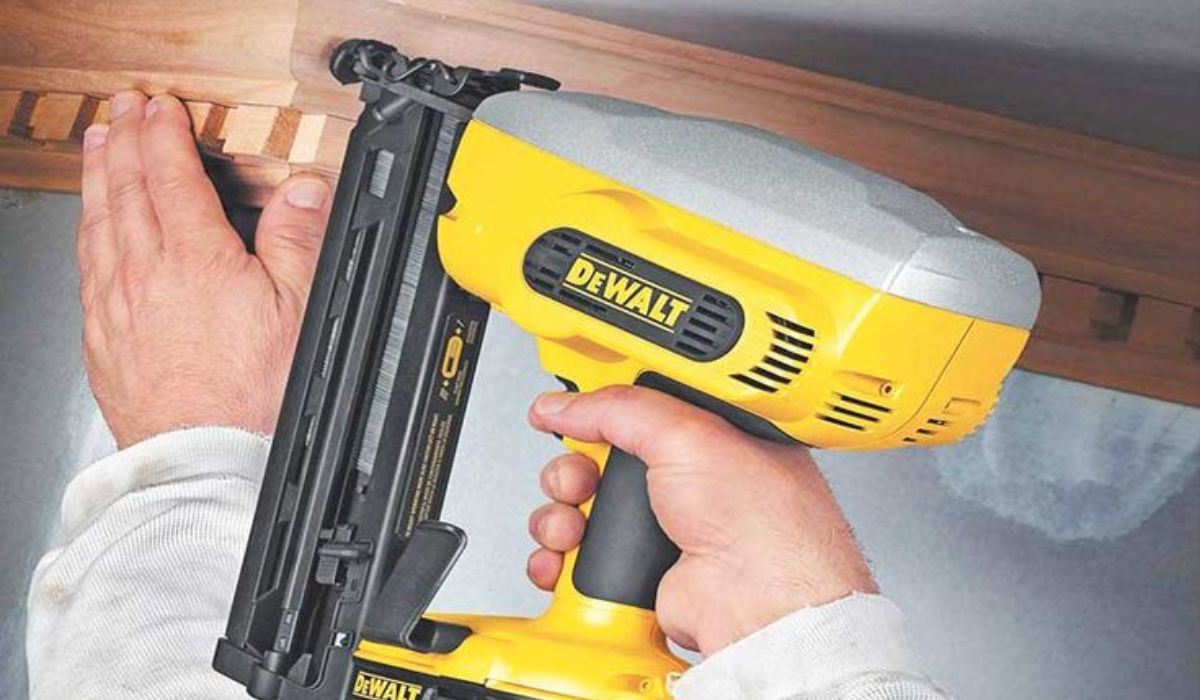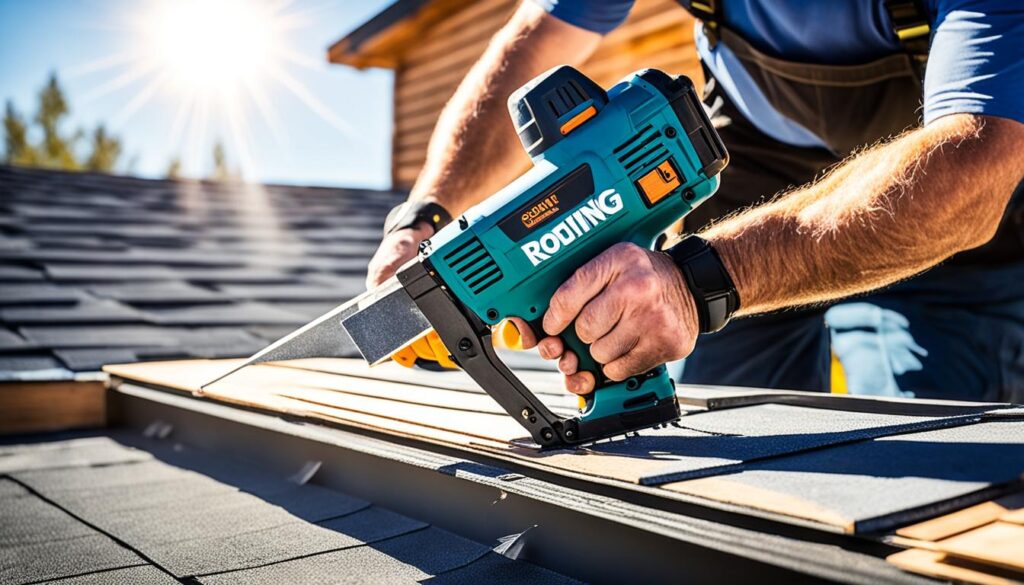
When you’re working on the roof, the tool you choose really matters. Roofing nail guns are the top pick for professionals and DIY fans alike. They’re great because they can use special coiled fasteners. This feature lets you work more, without having to stop often for refills. That means you’re safer up there on a sloped roof, not having to reload all the time.1 But, there are so many options out there. So, which lightweight roofing nail gun is the best for do-it-yourself projects?
Roofing guns are super popular now, even though some experts still prefer the old-fashioned hammer. Sure, nail guns can make your work faster, but they can also be dangerous. Thousands of people end up in the emergency room each year because of nail gun accidents. About 60% of these cases involve professionals like builders.1 Still, these tools are great for getting your roof job done quickly. In the U.S. alone, there are thirty different brands of roofing nail guns to choose from.1
Key Takeaways
- Roofing nail guns are specialized tools designed for roofing applications, featuring a shallower angle and coiled fasteners.
- While some contractors prefer the control of a roofing hammer, nail guns can significantly speed up roofing projects.
- Nail gun injuries are a concern, with around 42,000 emergency room visits annually, often due to reckless use.
- There are approximately 30 brands of roofing nailers available in the U.S. market.
- Choosing the best lightweight roofing nail gun for DIY projects requires considering factors like weight, balance, and safety features.
Introduction to Roofing Nail Guns
About 2,000 years ago, the concept of using air pressure began. A Greek named Hero of Alexandria invented the first steam-powered gadget.2 Later, a German introduced the vacuum pump. This step led to the creation of air-powered tools.
A Brief History of Nail Guns
In the 1940s, early roofing nail guns took shape. A civil engineer, part of Howard Hughes’ team, created the first known model. It was for the massive wooden airplane, the “Spruce Goose,” launched in 1947.
This nail gun made building the plane fast. People called it The “Flying Lumberyard.” It was a huge leap in construction technology.
The Rise of Nail Guns in Construction
During the 1950s and 1960s, nail guns began transforming construction. They allowed workers to finish jobs quicker and better.2 Roofing, especially, benefited from new nail guns. They became lightweight and easy to handle. Their special designs made them perfect for tight spots on roofs.
Nail Guns for Roofing
Roofing took a big step with the arrival of staple guns. At first, it was slow work without them.2 Pneumatic nailers were considered high-tech for roofers back then.
Staple guns changed everything in roofing by 1973.2 A team from Tennessee proved this by finishing 27 squares in a day. This achievement was a milestone in roofing history.
Types of Roofing Nail Guns
Roofing nail guns come in many types, all with special features.1 Pneumatic nail guns lead the pack, using air pressure to fire nails. This makes them quite common in the roofing world. Yet, some are powered by electricity and others by magnets. Then, there are those powered by explosive charges and even by gas cartridges.
Pneumatic Nailers
1 Pneumatic nail guns use air to shoot nails and are very liked. They have the strength and accuracy needed for roofing work. This is why pros and people doing their roofs often pick them.
Cordless Nailers
Cordless nail guns give roofers freedom. Without a cord, they can move around easily. This portable type is a top choice for roof fixes and upkeep by DIYers.
Combustion-Powered Nailers
1 Nail guns can get power in lots of ways. There are pneumatic, electric, and even gas-powered ones. Combustion-powered nail guns, for instance, run on gas. They are a good choice for roofer mobility.
Top Brands for Lightweight Roofing Nail Guns
When you’re looking for a top lightweight roofing nail gun, some brands really shine. Stanley Bostitch is one. They make cordless and air-powered roof nail guns. These are great for many purposes. They work well for rolling out composition roofs, putting up vapor barriers, insulation boards, and more. If you need something for fiber cement or vinyl siding, they’ve got you covered.1
Hitachi, which is now called Metabo HPT, is famous for its tough roofing nailers. They are built to last through hard job site use.3
Dewalt offers different types of power for its nailers. You can pick from models that need air or models that run on their 20V MAX battery system. This gives you choices to suit your needs.3
Senco is also a great choice for a roofing nailer. Even though theirs might be a bit heavier, they are known for their strong build. The way they balance the weight means you will have control and stability when using it.3
Lightweight Roofing Nail Gun for DIY
Roofing nail guns speed up DIY projects, letting you put up or fix roofs fast. Unlike hammers, many DIYers pick lightweight nail guns for their jobs. These tools are made for easy moving and using. They have special parts like angled magazines and adjustable depths.
and can hold up to 120 nails4. It works with air pressure from 70 to 100 PSI4 and can fire over 100,000 times4. Weighing 8.5 lb4, it’s light and easy to handle. It has a 1/4″ air inlet4 and needs 70 to 110 PSI4 to work. Plus, it uses air efficiently, and it comes with a 2-year warranty4.
The RoofPro™445XP coil nailer from RoofPro™ is even lighter, at 5.2 lbs (2.35 kgs)5. It’s small too, at 10.9″ tall by 10.6″ long by 4.5″ wide5. It needs 70 to 120 PSI or 4.8-8.3 Bar to work5. It uses 3.86 SCFM and has a 1/4″ air inlet5. The RoofPro™445XP can also hold 120 nails, which can be 3/4″ to 1-3/4″ long5.
These lightweight guns help DIYers take on roof work with power and precision. They’re designed to feel good in your hand and be easy to set up. That’s why DIY fans love them for top-notch roof repair, roofing maintenance, and roofing accessory tasks. With these guns, you can get pro-level results without being an expert in roofing.
Factors to Consider When Choosing a Lightweight Roofing Nail Gun
Choosing a roofing nail gun that’s light is important for DIY projects. You must look at its weight, how it feels in your hand, and how easy it is to adjust and use. These things help you work better and stay safe.3
Weight and Balance
A tool that’s light and balanced will keep you from getting tired. It will make using it for a long time easier and more efficient. This is key for any DIY or roofing work.3
Ease of Adjustment
Being able to change how the nail gun works easily is crucial. This includes things like how you load nails and control air pressure. Roofers who use their nail gun a lot need this to work smoothly.3
Firing Modes
Roofing nail guns have settings for how they shoot nails, like single shot or rapid fire modes. Picking the right one for your skill level is important. It affects how quickly and safely you can work.3
Corded vs. Cordless
You can pick a nail gun that uses a cord or one that’s cordless. Corded ones give power all the time but need an air compressor. Cordless ones are easy to move around with but their batteries can run out quickly.3

Nail Capacity and Adjustable Magazine
How many nails a gun can hold and how easy it is to load makes a difference. Bigger magazines mean less time stopping to reload. But, smaller ones are lighter and simpler to work with. Think about what your project needs to choose the best option for you.3
Safety Considerations for Roofing Nail Guns
Roofing nail guns need careful use to avoid accidents. About 42,000 people end up in emergency rooms yearly because of nail gun injuries caused by careless use.3 It’s key to use these tools properly, which means sticking to the instructions and safety rules from the maker.
Proper Handling and Usage
Being careful with roofing nail guns is a must. Make sure to follow what the maker and safety guidelines say. This helps stop accidents and keep you safe.3
Lockout Features
Lockout features are a big deal in staying safe. They stop the nail gun from shooting when it shouldn’t, helping it last longer and prevent harm.3
Personal Protective Equipment
Wearing the right gear is essential when using a roofing nail gun. You should put on safety glasses, gloves, and boots with steel toes. This gear keeps you safe from injuries that these strong tools can cause.3
Conclusion
Roofing nail guns are key for professional roofers and DIY fans. They offer speed and make work much easier when you’re putting up or fixing roofs.6 You can find them in different types like pneumatic, cordless, and combustion-powered. Each type has its own set of benefits.7
For DIY jobs, picking a light roofing nail gun is crucial. Think about its weight, if it’s easy to hold, how simple it is to use, and even how it shoots nails. Make sure you look at how it’s powered and how many nails it can hold.8 Safety is also really important. You have to use it the right way, make sure it has safety features, and wear gear like safety glasses.
Choosing the best roofing nail gun and using it safely means you’re ready to handle roof jobs. You can do your work with confidence and get results that look like they were done by a pro.
Recommended

Meet William Adams, a seasoned roofing expert with over 30 years of hands-on experience in the industry. Having worked tirelessly under the scorching sun and through the fiercest storms, William brings a wealth of knowledge and expertise to the table. Hailing from the heart of the USA, he’s witnessed the evolution of roofing practices firsthand, mastering every aspect along the way. Now retired from the field, William spends his days cherishing time with his loved ones while sharing his invaluable insights through this platform. With William at the helm, you can trust that every tip, advice, and recommendation provided is backed by years of real-world experience and unwavering dedication to quality craftsmanship. Join us as we journey through the world of roofing, guided by the wisdom and passion of a true industry veteran.
